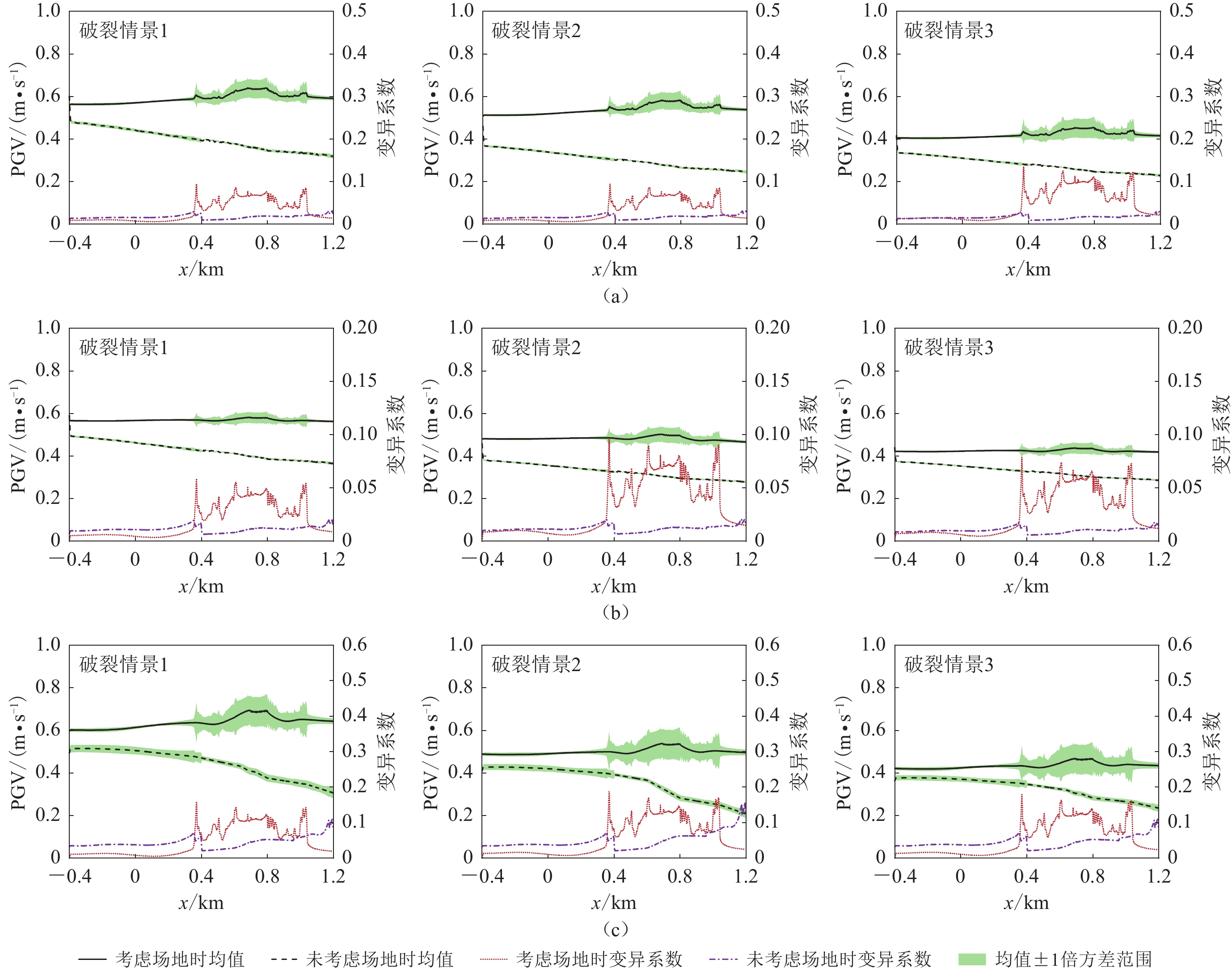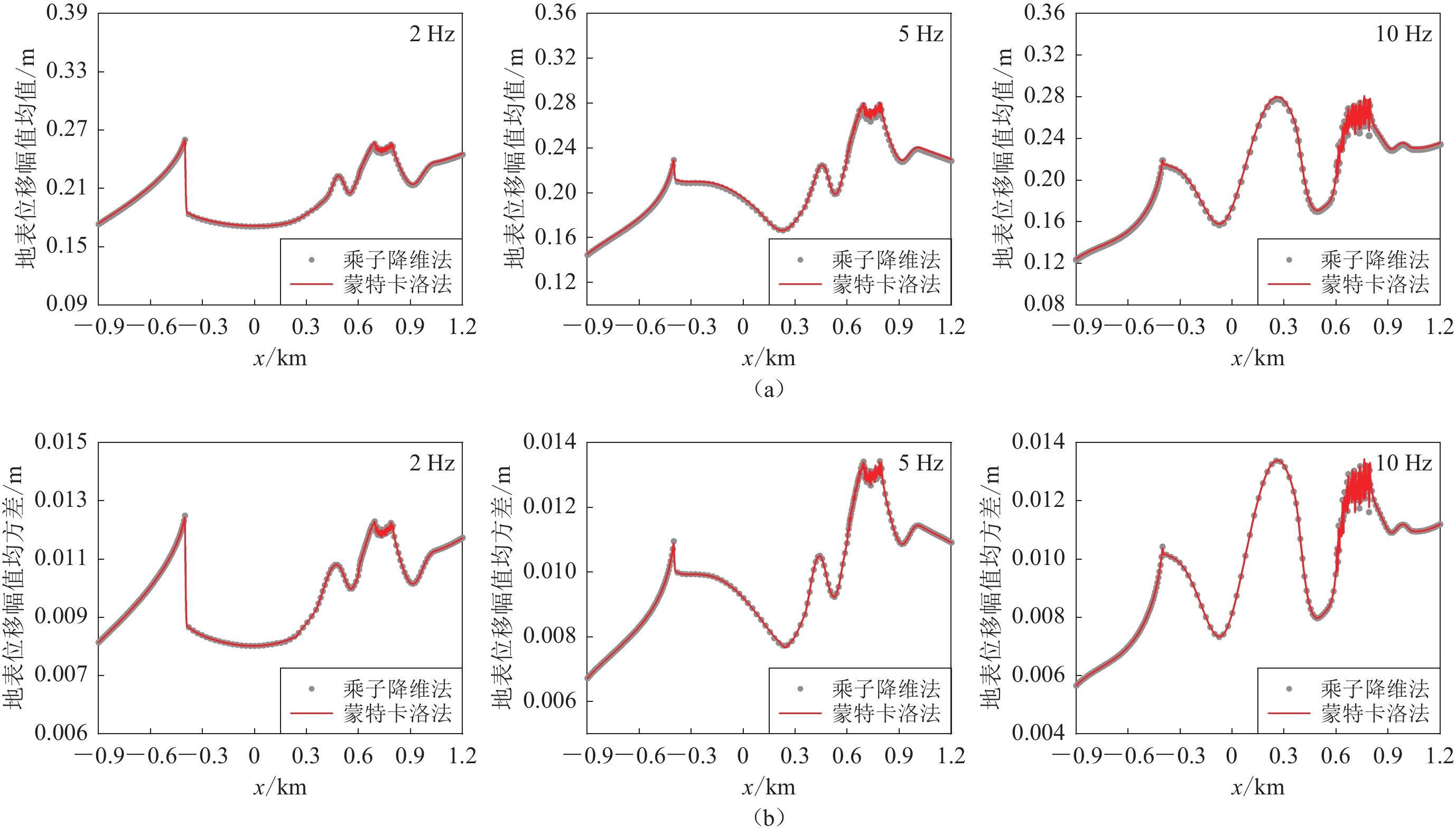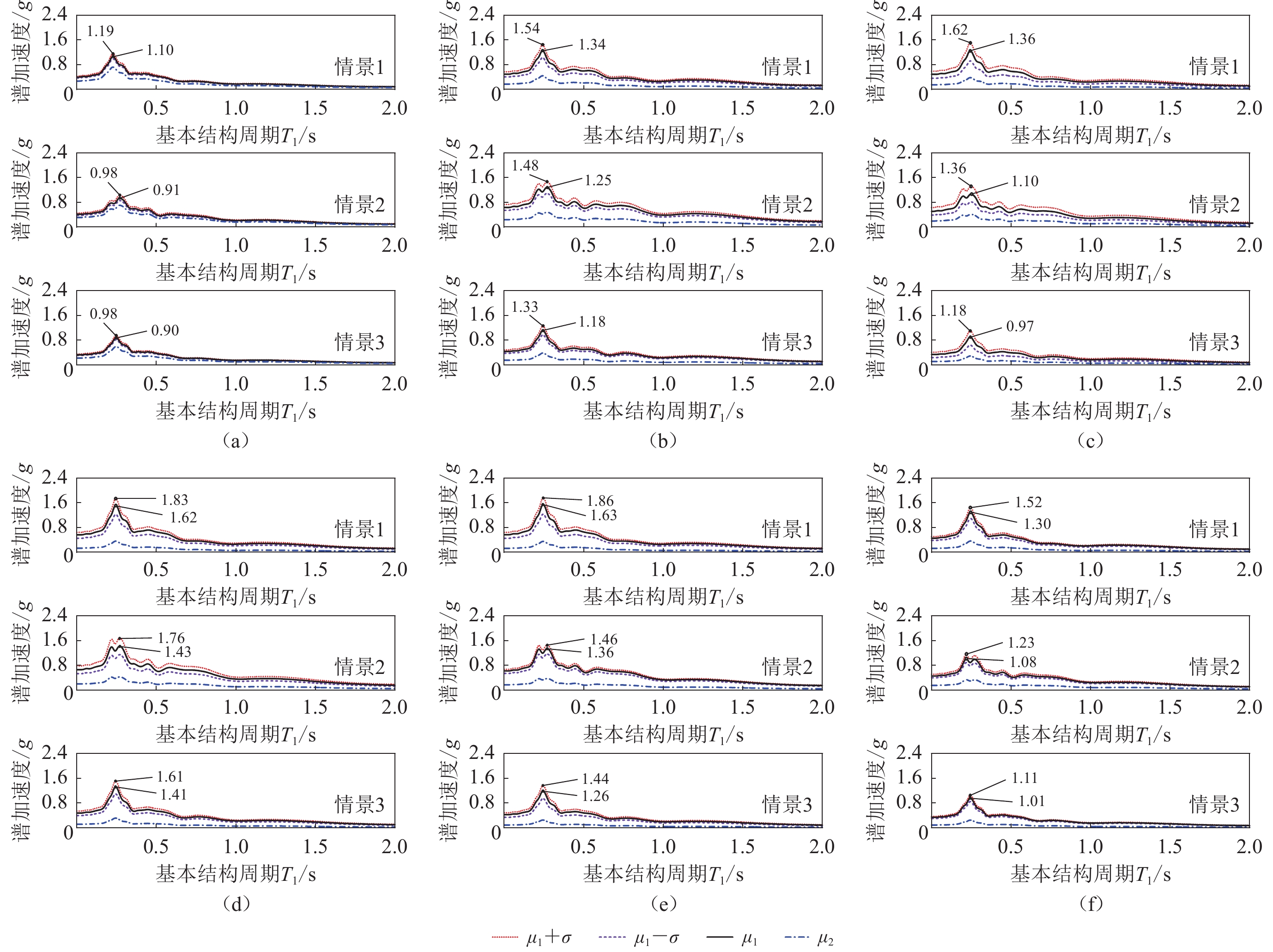Ground motion variability of a mountain-canyon site near a strike-slip fault considering uncertainty of source
-
摘要:
由于震源不确定性客观存在且对近地表地震动特性产生显著影响,尝试将乘子降维法应用至考虑震源不确定性的近断层复杂场地地震动变异性求解,将不确定性分析问题转换为有限次确定性分析,获得与蒙特卡洛模拟一致的地震动参数统计矩,其中单次确定性分析采用边界元法模拟断层破裂—传播路径—场地放大的整个物理过程。基于乘子降维法,以近走滑断层高山峡谷场地为例,分析了在近断层效应、场地效应和震源不确定性三者耦合作用下的场地地震动峰值加速度(PGA)、峰值速度(PGV)的空间分布变异性,以及关键地表点谱加速度(SA)的统计值。结果表明:乘子降维法适用于含震源参数不确定性的近断层复杂场地随机地震动求解;高山峡谷地形对地震波的散射效应叠加近断层效应后可引起断层上盘PGA和PGV均值的显著增大,可放大至两倍以上;震源不确定性经由场地传播,导致地表地震动变异性,PGA变异性强于PGV;考虑一倍均方差时,震源不确定性对结构反应的影响可达30%以上,大跨度工程结构还应考虑近断层地震动变异性的空间分布差异。
Abstract:A large number of railways and highways in the western part of China are located in near-fault mountain-canyon sites. The bridges and tunnels account for a large proportion due to the complex topography, and many important projects are faced with severe seismic risk. The ground motions in the near-fault mountain-canyon sites are very complex. On the one hand, velocity pulses and large vertical amplitudes are typical characteristics of the ground motions in near-fault regions; on the other hand, the topography of mountains and canyons leads to amplification and non-uniformity effects on ground motions. For example, the 1992 Hualien earthquake records show that the peak ground acceleration on the sidewalls of the Feitsui canyon in Taiwan is 2.69 times than that of the canyon bottom. In the 2008 Wenchuan earthquake, the peak ground acceleration in the east-west direction at the top of Xishan Mountain in Zigong is 1.77 times than that at the foot of the mountain. Theoretical and numerical analyses reveal that the physical essence of the amplification and non-uniformity effect is the scattering and local focusing of seismic waves by the topography of mountain-canyon sites.
In addition, the current technologies of geophysical prospecting make it difficult to finely determine the physical parameters of faults, interface slip characteristics, etc. It means that the fault rupture process has uncertainty. Based on the previous studies, the uncertainty of source existed objectively and had a significant impact on the characteristics of near-surface ground motions. In this study, it is an issue of quantifying uncertainty in ground motion parameters at near-fault mountain-canyon sites. Monte Carlo simulations and logic trees are commonly used to quantify the uncertainty in this problem. The main purpose is to construct different seismic scenarios, focusing on comparing the standard deviation of the spatial distribution of ground motions in the actual regional site with the standard deviation in the ground motion prediction model. It is worth pointing out that the Monte Carlo simulation has low efficiency to carry out the multidimensional uncertainty analysis. Besides, the simulation of ground motions in near-fault mountain-canyon sites needs to take into account near-fault and topography effects. Meanwhile, the uncertainty of the seismic source will cause random scattering of the seismic waves in mountain-canyon sites, which will lead to the variability of the ground motion parameters at various surface locations. However, the existing studies have not explored the propagation mechanism in depth.
In this paper, the multiplicative dimensional reduction method (M-DRM) is applied to solve the ground motion variability of complex sites near-fault considering the uncertainty of the source. The uncertainty analysis problem is converted into a finite deterministic analysis to obtain statistical moments of ground motion parameters consistent with Monte Carlo simulation. The deterministic analysis uses the boundary element method to simulate the entire physical process. Based on this method, the mountain-canyon site near a strike-slip fault was discussed as an example. The spatial distribution variability of the peak acceleration (PGA) and peak velocity (PGV) under the coupling of near-fault effect, site effect and source epistemic uncertainty was analyzed, as well as statistical values of spectral acceleration (SA) at some surface points.
The results indicated that the M-DRM is applied to the ground motion variability problem of near-fault mountain-canyon sites caused by seismic source uncertainty, which has higher computational efficiency compared with the conventional Monte Carlo simulation. This method can be used for the stochastic ground motion simulation of the complex sites based on the phylsical model and considering the uncertainty of seismic source. When there is a mountain-canyon topography in the near-fault region, the coupling of the near-fault effect and the local site effect causes a significant amplification of the mean values of the PGAs at the sites, which shows significant spatial variations, especially in the canyon. It can be up to 2.69 times that of the result without the local topography. The mean values of the variability of the PGVs at the different surface points are smaller than those of the PGAs. The structural periods corresponding to the maximum values of the surface ground motion acceleration response spectrum are basically the same under the conditions with and without mountain-canyon topography. The seismic source uncertainty is propagated through the site, which is finally manifested in the spatial distribution variability of PGAs and PGVs. Due to the different energy distributions of ground motion acceleration and velocity, there are differences in the variability of PGAs and PGVs. PGAs have larger coefficients of variation. The variability of PGAs and PGVs is different from that of a single parameter under different rupture scenarios when both the asperity intensity and the rupture velocity uncertainty are taken into account. However, the results of the acceleration response spectrum are more complicated. The variability of the structural response at different locations may be lower or higher than the superposition of single-parameter uncertainty variability, and it is affected by the location of the asperity.
-
Keywords:
- site effect /
- near-fault effect /
- source uncertainty /
- boundary element method
-
中国地震台网(2022)测定2022年9月5日12时52分四川泸定县(29.59°N, 102.08°E)发生MS6.8地震,震源深度为16 km。本次地震震中位于鲜水河断裂带(徐泰然等,2022),该断裂带北起甘孜东谷附近,向南经过炉霍、道孚、康定一线,至石棉县安顺场一带逐渐消失,全长约350 km,总体走向320°—330°,呈略向北凸出的弧形,与甘孜—玉树断裂共同构成川滇地块的北边界和巴颜喀拉地块的西南边界。鲜水河断裂带作为中国西南山区现今活动强烈的大型左旋走滑断裂带,具有规模大、活动强、地震频度高等特点(陈桂华等,2008)。自1700年以来,该断裂带发生过8次(泸定地震不计算在内)M≥7地震(图1中的红色圆点所示)。泸定地震则位于鲜水河断裂带南东段附近,与1786年发生的M7.8地震位置接近。快速测定这次地震的震源机制和地震辐射能量对研究该地震的发震构造和破坏能力有重要意义。
![]() 图 1 2022年泸定MS6.8地震的矩张量红色圆点为1 700年以来的8次M≥7.0地震,蓝色三角形为本文测定震源机制所使用的台站Figure 1. Moment tensor of the 2022 Luding MS6.8 earthquakeRed dots are the location of eight M≥7.0 earthquakes in the past 1 700 years,blue triangles are the location of the stations used in the determination of focal mechanism in this paper
图 1 2022年泸定MS6.8地震的矩张量红色圆点为1 700年以来的8次M≥7.0地震,蓝色三角形为本文测定震源机制所使用的台站Figure 1. Moment tensor of the 2022 Luding MS6.8 earthquakeRed dots are the location of eight M≥7.0 earthquakes in the past 1 700 years,blue triangles are the location of the stations used in the determination of focal mechanism in this paper本文利用近震全波形反演方法(Chiang et al,2016)求取矩心矩张量解,该方法基于点源模型,在时间域上利用广义最小二乘法(Minson,Dreger,2008)对三分量完整波形进行反演,继而利用能流密度法(Newman,Okal,1998)测定地震辐射能量ER。
泸定地震震级较大,考虑到震中距较小的台站存在限幅情况、震中距较大的台站存在数据质量问题,我们选取国家测震台网数据备份中心(郑秀芬等,2009)提供的震中距处于158—327 km内13个高质量台站(图1蓝色三角形所示)的记录进行反演。数据预处理时滤波频段选取为0.02—0.05 Hz,震源深度的搜索范围为6—13 km,步长为1 km。本文使用频率-波数法计算1 Hz理论格林函数(Wang,Herrmann,1980;Herrmann,Wang,1985;Herrmann,2013),使用Xin等(2019)提供的中国大陆一维地壳速度模型(图2)。拟合度最大值对应的深度为矩心深度,矩心深度对应的结果即为本文最终测定的震源机制解。图3是拟合度与矩心深度的关系,由该图可以确定矩心深度为9 km,拟合度达70%以上。该深度所对应的震源机制解节面Ⅰ的走向为77°,倾角为83°,滑动角为178°;节面Ⅱ的走向为347°,倾角为88°,滑动角为−7°;地震矩为1.3×1019 N·m,折合为矩震级MW6.7。图4为矩心深度为9 km时实际波形与理论波形的对比图,可见所有台站的平均拟合度为71%,拟合程度较高,可被看作可靠的结果。
![]() 图 2 泸定MS6.8地震震源区的一维速度模型(数据来自于Xin et al,2019)Figure 2. One-dimensional velocity model of source area of Luding MS6.8 earthquake (data from Xin et al,2019)
图 2 泸定MS6.8地震震源区的一维速度模型(数据来自于Xin et al,2019)Figure 2. One-dimensional velocity model of source area of Luding MS6.8 earthquake (data from Xin et al,2019)![]() 图 4 泸定MS6.8地震最佳拟合矩心深度为9.0 km时的波形拟合Δ为震中距,θ为方位角,TS为时延+20 s,VR为理论波形(红色)与实际波形(黑色)的拟合度Figure 4. Waveform fitting with the best fitting centroid depth of 9.0 km for the Luding MS6.8 earthquakeΔ is the epicentral distance,θ is the azimuth,TS is the time delay plus 20 s,and VR is a parameter describing the fitting degree of the theoretical waveform (red) and the actual waveform (black)
图 4 泸定MS6.8地震最佳拟合矩心深度为9.0 km时的波形拟合Δ为震中距,θ为方位角,TS为时延+20 s,VR为理论波形(红色)与实际波形(黑色)的拟合度Figure 4. Waveform fitting with the best fitting centroid depth of 9.0 km for the Luding MS6.8 earthquakeΔ is the epicentral distance,θ is the azimuth,TS is the time delay plus 20 s,and VR is a parameter describing the fitting degree of the theoretical waveform (red) and the actual waveform (black)表1给出了国内外不同机构和作者关于泸定地震的震源机制解结果(防灾科技学院河北省地震动力学重点实验室Seismology小组,2022),以及本文结果与这些震源机制解的最小空间旋转角,在此基础上本文给出了泸定地震的震源机制解(图5)。表1显示,本文结果与其它结果的最小空间旋转角为4.5°,最大空间旋转角为24.2°,且基本集中在20°以下。Kagan (1991)指出最小空间旋转角小于20°时可以认为是相同的震源机制,因此结合表1和图5可知本文结果与其他机构或者作者的结果较一致。
表 1 不同机构和作者给出的泸定地震震源机制解Table 1. Focal mechanism solutions of Luding earthquake given by different organizations and authors序号 机构或作者 震源机制解 本文结果与相应结果的
最小空间旋转角/°走向/° 倾角/° 滑动角/° 1 USGS 159 82 −4 14.5 2 GCMT 163 80 8 9.2 3 GFZ 164 85 6 4.5 4 IPGP 163 71 −3 19.8 5 四川地震台 172 74 27 24.2 6 中国地震台网中心 343 79 9 21.3 7 王卫民 166 75 0 14.7 8 郭祥云 335 74 −15 22.6 9 韩立波和蒋长胜 343 89 −34 17.8 注:USGS:美国地质调查局;GCMT:美国哥伦比亚大学全球矩心矩张量解中心;GFZ:亥姆霍兹波茨坦中心;IPGP:法国巴黎地
球物理学院。表中震源机制数据引自防灾科技学院河北省地震动力学重点实验室Seismology小组(2022)。根据本次地震震源附近的地质构造,结合本次地震破裂面较深的特点,可知泸定地震是巴颜喀拉地块在向东挤压受到四川盆地阻挡后向南侧挤压的物理过程中产生的高倾角左旋走滑型地震。
从地震学合作研究协会(Incorporated Research Institutions for Seismology,缩写为IRIS)网站下载25个台站(图6a)的宽频带波形数据,这些地震台的震中距范围为11°—58°。使用之前得到的震源机制对地震辐射能量测定结果进行修正,将修正后所有台站的地震辐射能量平均值作为该事件的辐射能量,依此得到本次地震的辐射能量ER为4.1×1014 J,高频(0.5—2 Hz)辐射能量ERH为5.45×1013 J,能量震级Me约为6.8,标准差为0.34。图6b为单台能量震级的偏差统计图,可知每个台站的能量震级稳定分布在6.2—7.4之间。由于地震以地震波形式辐射的能量主要集中在震源谱的拐角频率附近,高频(0.5—2 Hz)辐射能量ERH对于分析一个地震的破坏能力很有价值,经由本次地震与2013年4月20日芦山MS7.0地震的对比得以证明。
2013年4月20日的芦山MS7.0地震破坏严重,与本次地震仅相距116 km。中国地震局(2013)和应急管理部(2022)通过地震现场工作队实地调查,并充分参考震区断裂构造、仪器烈度、余震分布、震源机制、无人机遥感等科技支撑成果,结合强震动观测记录,分别确定了这两次地震的烈度分布。芦山地震的最高烈度为Ⅸ度,Ⅸ度烈度区的长半轴为11.5 km,短半轴为5.5 km,面积为208 km2,Ⅵ度及以上烈度区的总面积为18 682 km2;泸定地震的最高烈度为Ⅸ度,面积为280 km2,等震线长轴呈NW走向,Ⅵ度及以上烈度区面积为19 089 km2。泸定地震的Ⅸ度区的面积较芦山地震大72 km2,Ⅵ度及以上烈度区面积大407 km2,所造成的灾害更为严重。而从表2所示的两次地震的面波震级MS、矩震级MW、地震辐射能量ER和高频地震辐射能量ERH的对比来看,芦山地震的面波震级MS比泸定地震大0.2,矩震级MW和地震辐射能量ER十分接近,这几个参数均无法解释泸定地震产生的破坏更为严重,但从高频地震辐射能量ERH来看,泸定地震明显大于芦山地震,这与泸定地震面波震级低受灾情况却更为严重的情况相符。因此,地震辐射能量ER能够反映震源动态特征,与地震震源的动力学特性(如地震波频率、地震波速度等)密切相关,更适合表征地震的破坏能力,因此高频地震辐射能量ERH可作为量化地震破坏能力的参数。
表 2 2013年4月20日芦山MS7.0地震与2022年9月5日泸定MS6.8地震的地震参数对比Table 2. Comparison of seismic parameters between the Lushan MS7.0 earthquake on April 20,2013 and the Luding MS6.8 earthquake on September 5,2022发震时间 发震地点 MS MW 地震辐射能量ER/(1014 J) 高频地震辐射能量ERH/(1014 J) 2013-04-20 四川芦山 7.0 6.6 4.3 4.8 2022-09-05 四川泸定 6.8 6.7 4.1 5.5 使用Convers和Newman (2013)的方法计算破裂持续时间T,选取所有台站的中位数可得这次地震的破裂持续时间为16 s。依据Bormann和Saul (2009)关于矩震级MW与平均破裂持续时间Tavg的经验关系lgTavg=0.6MW-2.8将本次地震的矩震级MW6.7代入得到该震级对应的平均破裂持续时间为17 s,即泸定地震的破裂持续时间短于平均破裂持续时间。
能矩比(地震辐射能量与地震矩的比值ER/M0,也称为折合能量)是衡量震源释放地震波能力的重要参数。使用本文结果计算的泸定地震能矩比约为3.1×10−5,与全球走滑型地震平均能矩比3.6×10−5 (Convers,Newman,2011)相比,泸定地震的能矩比并不突出,但是走滑型地震的能量释放能力本身就比较突出,因此泸定地震具有的破坏能力在同震级的地震中仍应当属于比较强的。
视应力可以反映地震断层释放累积能量的水平,使用本文结果得到泸定地震的视应力为0.95 MPa,高于吴忠良等(2002)利用美国国家地震信息中心宽频带辐射能量目录和全球矩心矩张量项目目录给出的中国大陆西部地区视应力的平均值0.8 MPa,说明此次地震的地震断层释放出了较强的能量。
Baltay等(2011)对日本M1.8—6.9地震序列进行了基于经验格林函数的尾波分析,得到了布龙应力降$\Delta \sigma $与视应力$\sigma_{\rm{app}} $的经验关系$\Delta\sigma/\sigma_{\rm{app}}=4.3 $ (Singh,Ordaz,1994)适用于拐角频率较低的中强震(MW≥5.0),本文根据视应力σapp结果得出泸定地震的布龙应力降约为4.09 MPa。
Ye等(2018)计算了全球MW>7.0地震的辐射能量增强因子REEF值,得到了区域性的统计规律,这些地震的REEF值范围在5—150之间。本次测定泸定地震的REEF值为49,属于正常范围。大量测定中国大陆中强震的REEF值,并结合地震的实际情况进行综合分析,可能会得到一些有意义的统计规律,这还有待使用更多震例进行研究。
本文使用宽频带波形数据对2022年9月5日泸定MS6.8地震的震源辐射能量和震源机制进行测定,并计算了一些衍生的参数,对结果进行分析和讨论后,得到以下结论:
1) 使用区域波形数据,采用近震时域全波形反演方法得到泸定地震的地震矩为1.3×1019 N·m,转化为矩震级为MW6.7,矩心深度约为9 km,震源机制解节面Ⅰ的走向为77°、倾角为83°、滑动角为178°,节面Ⅱ的走向为347°、倾角为88°、滑动角为−7°。
2) 基于全球地震台网提供的波形资料,使用能流密度法测定泸定地震的辐射能量为4.1×1014 J,其中的高频部分(0.5—2 Hz)为5.5×1013 J,地震辐射能量转化成能量震级为6.8,震源破裂时间为16 s。与2013年4月20日的芦山MS7.0地震的对比说明:对于地震灾害和风险评估,测定地震辐射能量及其在频谱上的分布、破裂持续时间等动态震源参数是十分必要的。根据上面的分析,可认为本次地震短时间内释放出了大量的地震能量,是破坏能力较强的地震。
3) 计算得出本次地震的能矩比为3.1×10−5,视应力为0.95 MPa,布龙应力降约为4.09 MPa,可以认为本次地震的能量释放效率较高。结合静态震源参数地震矩M0、动态地震参数地震辐射能量ER和破裂持续时间T以及震源附近的介质属性参数如密度ρ和S波速度得出描述震源破裂复杂程度的辐射能量增强因子REEF为49。
地震矩等静态震源参数主要与地震波的低频成分有关,在构造动力学研究中具有重要意义;地震辐射能量等动态震源参数主要与地震波的高频成分有关,在工程地震学研究中具有重要意义。联合测定地震矩和地震辐射能量,对于研究区域构造、快速评估地震灾害、开展地震应急响应工作都具有重要意义。
-
图 9 近断层场地PGV空间分布变异性
(a) 考虑凹凸体强度不确定性;(b) 考虑破裂速度不确定性;(c) 同时考虑凹凸体强度和破裂速度不确定性
Figure 9. Spatial distribution variability of PGVs in the near-fault site
(a) Considering asperity intensity uncertainty ;(b) Considering rupture velocity uncertainty;(c) Considering asperity intensity and rupture velocity uncertainty
图 2 不同断层角度下本文方法与Kara和Trifunac (2014)方法所得地表位移结果对比
(a) 倾角为π/24;(b) 倾角为π/4;(c) 倾角为π/2
Figure 2. Comparison of surface displacement results obtained by the proposed method and the method in reference Kara and Trifunac (2014) under different fault angles
(a) Dip angle of π/24;(b) Dip angle of π/4;(c) Dip angle of π/2
图 10 考虑凹凸体强度不确定性时近断层场地SA空间分布变异性
(a) A点;(b) B点;(c) C点;(d) D点;(e) E点;(f) F点。μ1和μ2分别代表有、无高山峡谷地形时观测点SA均值,σ为存在高山峡谷地形时观测点SA均方差,阻尼比取为0.05,下同
Figure 10. Spatial distribution variability of SAs in the near fault site considering asperity intensity uncertainty
(a) Point A;(b) Point B;(c) Point C ;(d) Point D;(e) Point E;(f) Point F. μ1 and μ2 represent mean SAs at observed points with and without the mountain-canyon site, σ represents the root mean squares of SAs at observed points with the mountain-canyon site,and the damping ratio is 0.05,the same below
表 1 边界元法数值稳定性验证 (η=0.25)
Table 1 Numerical stability verification of boundary element method (η=0.25)
x/a 边界元法参数 解析解 N=600,
L=561N=1 000,
L=801N=1 400,
L=1 041−2.0 0.070 3 0.070 7 0.070 4 0.070 4 −1.5 0.091 3 0.090 9 0.090 8 0.090 8 −1.0 0.518 9 0.519 9 0.522 6 0.522 6 −0.5 0.495 0 0.516 7 0.551 2 0.551 2 0.5 0.744 8 0.749 8 0.754 7 0.754 7 1.0 0.494 2 0.547 7 0.551 2 0.551 2 1.5 0.097 8 0.099 2 0.100 3 0.100 3 2.0 0.083 3 0.084 0 0.084 6 0.084 6 -
巴振宁,吴孟桃,梁建文,喻志颖. 2020. 高山—峡谷复合地形对入射平面P-SV波的散射[J]. 应用数学和力学,41(7):695–712. Ba Z N,Wu M T,Liang J W,Yu Z Y. 2020. Scattering and diffraction by the hill-canyon composite topography for incident plane P- and SV-waves[J]. Applied Mathematics and Mechanics,41(7):695–712 (in Chinese).
陈畅,吴军,黄炬斌,代劲松. 2019. 新建川藏铁路雅安至林芝段出渣综合利用及处置对策研究[C]//川藏铁路工程建造技术研讨会论文集. 北京:中国铁建股份有限公司:25−28. Chen C,Wu J,Huang J B,Dai J S. 2019. Study on comprehensive utilization and disposal countermeasures of slag from Ya'an to Linzhi section of newly constructed Sichuan−Tibet railway[C]//Proceedings of Sichuan-Tibet Railway Engineering Construction Technology Seminar. Beijing:China Railway Construction Corporation:25−28 (in Chinese).
陈笑宇,王东升,付建宇,国巍. 2021. 近断层地震动脉冲特性研究综述[J]. 工程力学,38(8):1–14. Chen X Y,Wang D S,Fu J Y,Guo W. 2021. State-of-the-art review on pulse characteristics of near-fault ground motions[J]. Engineering Mechanics,38(8):1–14 (in Chinese).
雷涛,李碧雄,曹鹏杰,顺远坤. 2010. 汶川地震近断层附近桥梁震害浅析[J]. 重庆交通大学学报(自然科学版),29(3):358–362. Lei T,Li B X,Cao P J,Shun Y K. 2010. Analysis on damage of near-faultage bridges in Wenchuan earthquake[J]. Journal of Chongqing Jiaotong University (Natural Science),29(3):358–362 (in Chinese).
李宁,刁泽民,李忠献. 2022. 考虑震源和场地特征的近断层地区竖向地震动合成研究[J]. 工程力学,39(6):181–190. Li N,Diao Z M,Li Z X. 2022. Study on synthesis method of vertical ground motions for near-fault regions considering the characteristics of source and site condition[J]. Engineering Mechanics,39(6):181–190 (in Chinese).
李郑梁,李建春,刘波,聂萌萌. 2021. 浅切割的高山峡谷复杂地形的地震动放大效应研究[J]. 工程地质学报,29(1):137–150. Li Z L,Li J C,Liu B,Nie M M. 2021. Seismic motion amplification effect of shallow-cutting hill-canyon composite topography[J]. Journal of Engineering Geology,29(1):137–150 (in Chinese).
罗全波,陈学良,高孟潭,李宗超,李铁飞. 2019. 近断层速度脉冲地震动的三维有限差分模拟[J]. 地震工程学报,41(6):1630–1636. Luo Q B,Chen X L,Gao M T,Li Z C,Li T F. 2019. Three-dimensional finite-difference simulation of near-fault velocity pulse-like ground motions[J]. China Earthquake Engineering Journal,41(6):1630–1636 (in Chinese).
王海云,谢礼立. 2010. 自贡市西山公园地形对地震动的影响[J]. 地球物理学报,53(7):1631–1638. Wang H Y,Xie L L. 2010. Effects of topography on ground motion in the Xishan park,Zigong city[J]. Chinese Journal of Geophysics,53(7):1631–1638 (in Chinese).
王伟,刘必灯,刘欣,杨明亮,周正华. 2015. 基于汶川MS8.0地震强震动记录的山体地形效应分析[J]. 地震学报,37(3):452–462. Wang W,Liu B D,Liu X,Yang M L,Zhou Z H. 2015. Analysis on the hill topography effect based on the strong ground motion records of Wenchuan MS8.0 earthquake[J]. Acta Seismologica Sinica,37(3):452–462 (in Chinese).
袁飞云,王剑波. 2018. 雅康高速长下坡高桥隧比路段交通安全设施优化设计研究[J]. 交通科技,(5):114–117. Yuan F Y,Wang J B. 2018. Research on optimum design of traffic safety facilities for Ya’an-Kangding expressway at long downhill and high ratio of bridge tunnel section[J]. Transportation Science and Technology,(5):114–117 (in Chinese).
张冬锋. 2019. 随机有限断层法参数不确定性分析及其在近场地震动模拟中的工程应用研究[D]. 北京:中国地震局地球物理研究所:26−29. Zhang D F. 2019. Parameter Uncertainty Analysis of Stochastic Finite-Fault Method and Its Application in Near-Field Ground Motion Simulation[D]. Beijing:Institute of Geophysics,China Earthquake Administration:26−29 (in Chinese).
Ameri G,Gallovic F,Pacor F,Emolo A. 2009. Uncertainties in strong ground-motion prediction with finite-fault synthetic seismograms:An application to the 1984 M5.7 Gubbio,Central Italy,Earthquake[J]. Bull Seismol Soc Am,99(2A):647–663. doi: 10.1785/0120080240
Bjerrum L W,Sørensen M B,Ottemöller L,Atakan K. 2013. Ground motion simulations for İzmir,Turkey:Parameter uncertainty[J]. J Seismol,17(4):1223–1252. doi: 10.1007/s10950-013-9389-9
Cao Z L,Tao X X,Tao Z R,Tang A P. 2019. Kinematic source modeling for the synthesis of broadband ground motion using the f-κ approach[J]. Bull Seismol Soc Am,109(5):1738–1757.
Fortuño C,de la Llera J C,González G,González J,Aguirre P. 2021. Rupture parameter sensitivity of low frequency ground motion response spectra using synthetic scenarios in North Chile[J]. Bull Earthq Eng,19(12):4833–4864. doi: 10.1007/s10518-021-01113-0
Hartzell S,Frankel A,Liu P C,Zeng Y H,Rahman S. 2011. Model and parametric uncertainty in source-based kinematic models of earthquake ground motion[J]. Bull Seismol Soc Am,101(5):2431–2452. doi: 10.1785/0120110028
Haskell N A. 1964. Total energy and energy spectral density of elastic wave radiation from propagating faults[J]. Bull Seismol Soc Am,54(6A):1811–1841. doi: 10.1785/BSSA05406A1811
Huang H C,Chiu H C. 1995. The effect of canyon topography on strong ground motion at Feitsui damsite:Quantitative results[J]. Earthq Engin Struct Dyn,24(7):977–990. doi: 10.1002/eqe.4290240705
Iwaki A,Morikawa N,Maeda T,Fujiwara H. 2017. Spatial distribution of ground-motion variability in broadband ground-motion simulations[J]. Bull Seismol Soc Am,107(6):2963–2979. doi: 10.1785/0120170150
Kara H F,Trifunac M D. 2014. Two-dimensional earthquake vibrations in sedimentary basins:SH waves[J]. Soil Dyn Earthq Eng,63:69–82. doi: 10.1016/j.soildyn.2014.03.010
Liu Z X,Liu Y,Huang L,Li Y R,Zhao R B. 2021. Indirect boundary element method solution to the seismic ground motion of near-fault sedimentary valley[J]. Eng Anal Bound Elem,132:289–308.
Liu Z X,Zhou T,Meng S B,Jin L G. 2022. 2-D FM-IBEM simulation of broadband ground motions on near-fault mountain-valley coupling site[J]. Eng Anal Bound Elem,145:224–241. doi: 10.1016/j.enganabound.2022.09.020
Sánchez-Sesma F J,Campillo M. 1991. Diffraction of P,SV,and Rayleigh waves by topographic features:A boundary integral formulation[J]. Bull Seismol Soc Am,81(6):2234–2253.
Yamada M,Senna S,Fujiwara H. 2011. Statistical analysis of ground motions estimated on the basis of a recipe for strong-motion prediction:Approach to quantitative evaluation of average and standard deviation of ground motion distribution[J]. Pure Appl Geophys,168(1/2):141–153.
Zhang J,Bi K M,Zheng S X,Jia H Y,Zhang D Y. 2018. Seismic system reliability analysis of bridges using the multiplicative dimensional reduction method[J]. Struct Infrastruct E,14(11):1455–1469. doi: 10.1080/15732479.2018.1450428
Zhang X F,Pandey M D. 2013. Structural reliability analysis based on the concepts of entropy,fractional moment and dimensional reduction method[J]. Struct Saf,43:28–40. doi: 10.1016/j.strusafe.2013.03.001
-
期刊类型引用(2)
1. 赵小艳,苏有锦,孟令媛,臧阳. 2024年新疆乌什7.1级地震和中国台湾花莲7.3级地震前的大震长期平静及中国大陆强震危险性研究. 地震研究. 2025(01): 32-40 .  百度学术
百度学术
2. 李其栋,谢卓娟,周懿国. 川西地区中强地震前后b值异常特征研究. 地震地磁观测与研究. 2024(06): 28-38 .  百度学术
百度学术
其他类型引用(0)





 下载:
下载:
















